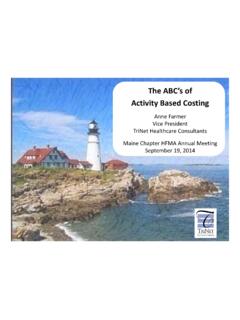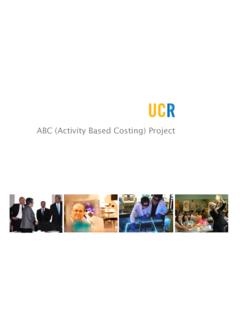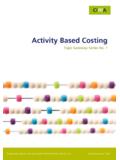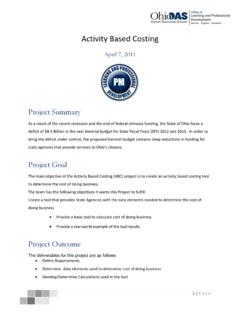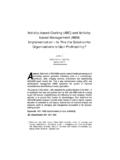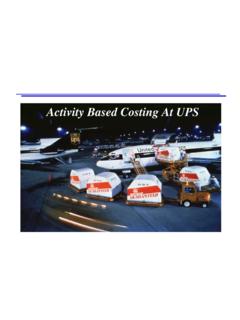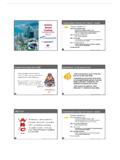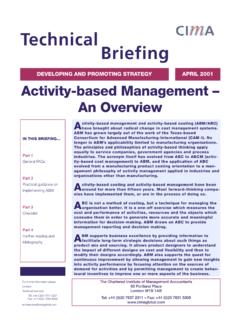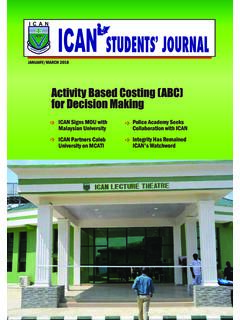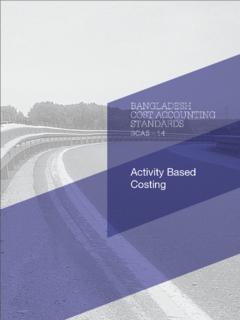Transcription of Time-Driven Activity-Based Costing - RozUp.Ir
1 Time-Driven Activity-Based Costing Robert S. Kaplan and Steven R. Anderson November 2003 Abstract The traditional ABC model has been difficult for many organizations to implement because of the high costs incurred to interview and survey people for the initial ABC model, the use of subjective and costly-to-validate time allocations, and the difficulty of maintaining and updating the model as (i) processes and resource spending change, (ii) new activities are added, and (iii) increases occur in the diversity and complexity of individual orders, channels and customers. Time-Driven ABC requires estimates of only two parameters: (1) the unit cost of supplying capacity and (2) the time required to perform a transaction or an activity .
2 A Time-Driven ABC model: can be estimated and installed quickly is easily updated to reflect changes in processes, order variety, and resource costs can be data fed from transactional ERP and CRM systems can be validated by direct observation of the model s estimates of unit times can scale easily to handle millions of transactions while still delivering fast processing times and real- time reporting explicitly incorporates resource capacity and highlights unused resource capacity for management action exploits time equations that incorporate variation in orders and customer behavior without expanding model complexity The paper uses simple numerical examples to articulate the fundamentals of Time-Driven ABC and provides several examples of
3 Companies that have implemented the approach and enjoyed rapid and significant profit improvements. 2 Time-Driven activity based - Costing Activity-Based Costing was introduced in the mid-1980s through several Harvard Business School cases and While the settings of these cases differed, they all had one characteristic in common. The resource expenses assigned to an activity were determined through interviews, time logs, and direct observation of the amount or percentage of time people spent on various activities. For example, the costs of warehousing goods would be driven to activities such as Receiving, Inspection, Put-away, Picking, Packing, and Shipping based on estimates by warehouse personnel of the percentage of their time they spent on each of the activities.
4 The project team then calculated activity cost driver rates, used to assign activity costs to individual products or customers, by dividing these activity costs by the outputs of each activity such as number of receipts, number of inspections, number of items picked, and number of shipments. This procedure for estimating an ABC model, while feasible for initial pilot studies, has proved difficult and costly to extend to company-wide applications. Also, even after the initial model has been built, updating the model requires essentially re-estimating through a new round of interviews and surveys to reflect changes in a company s operations.
5 Consequently, ABC models are often not maintained and their cost estimates soon become obsolete. In this paper, we review the problems associated with traditional estimation of ABC models. We describe a new approach that is both simpler for estimating and maintaining an ABC model and also more accurate. The new, Time-Driven approach allows for more heterogeneity in activities, orders, and customer behavior without placing burdensome demands for calculating activity , product and customer costs. Estimating a Basic ABC Model The standard procedure for estimating a simple ABC model starts with identifying a collection of resources that perform a variety of activities.
6 For example, consider a customer service department that performs three activities: handle customer orders process customer complaints perform customer credit checks. Assume that the cost of supplying resources personnel, supervision, information technology, telecommunications, and occupancy to perform these activities is $560,000 per quarter. In building an ABC model for the customer service department, the system designer asks employees to estimate the percentage of their time spent (or that they expect to spend) on the three principal activities they perform. Suppose they estimate 3these percentages as 70%, 10% and 20%, respectively.
7 The ABC system designer also learns that the actual (or estimated) quantities of work for the quarter in these three activities are: 9,800 customer orders 280 customer complaints 500 credit checks The system assigns the $560,000 resource cost to activities, based on the time percentage, and calculates activity cost driver rates as shown below: activity Cost activity Cost activity % Assigned Cost Driver Quantity Driver Rate Handle orders 70% $392,000 9,800 $ 40/order Process complaints 10% 56,000 280 $200/complaint Check credit 20% 112,000 500 $224/credit check Total 100% $ 560,000 The project team then uses the calculated activity cost driver rates to assign the expenses of the three activities to individual customers based on the number of orders handled, complaints processed.
8 And credit checks performed for each customer. This approach works well in the limited setting in which it was initially applied, typically a single department, plant or location. Also, many of the initial studies were one- time events that provided a useful snapshot of the plant s current economics, such as to identify high cost, inefficient processes and the unprofitable products and customers. Even today, the revelation of high cost processes, products and customers stimulates near-term actions ( Activity-Based management) that can lead to near-term and often dramatic profit improvements. Problems with Estimating and Maintaining ABC Models Several problems, however, arise when companies attempt to scale up this seemingly straightforward approach to enterprise-wide models, and to maintain the model so that it reflects changes in activities, processes, products, and customers.
9 First, the process to interview and survey employees to get their time allocations to multiple activities is time consuming and costly. Consider the experience of a money center bank s brokerage operation. Its traditional ABC model required 70,000 employees at more than 100 facilities to submit monthly surveys of their time . The company had to provide 14 full- time people just to manage the ABC data collection, processing and reporting. A $20 billion distributor required several months and about a dozen employees to update its internal ABC model. The high time and cost to estimate an ABC model and to maintain it through re-interviews and re-surveys has been a major barrier to widespread ABC adoption.
10 And, because of the high cost of continually updating the ABC model, many ABC systems are updated only infrequently, leading to out-of-date activity cost driver rates, and inaccurate estimates of process, product, and customer costs. 4 The accuracy of the cost driver rates when they are derived from individuals subjective estimates of their past or future behavior has also been called into Apart from the measurement error introduced by employees best attempts to recall their time allocations, the people supplying the data anticipating how it might be used might bias or distort their responses. As a result, operations, sales and marketing managers often argue about the accuracy of the model s estimated costs and profitability rather than address how to improve the inefficient processes, unprofitable products and customers, and considerable excess capacity that the model has Another problem is that traditional ABC models are difficult to scale.
